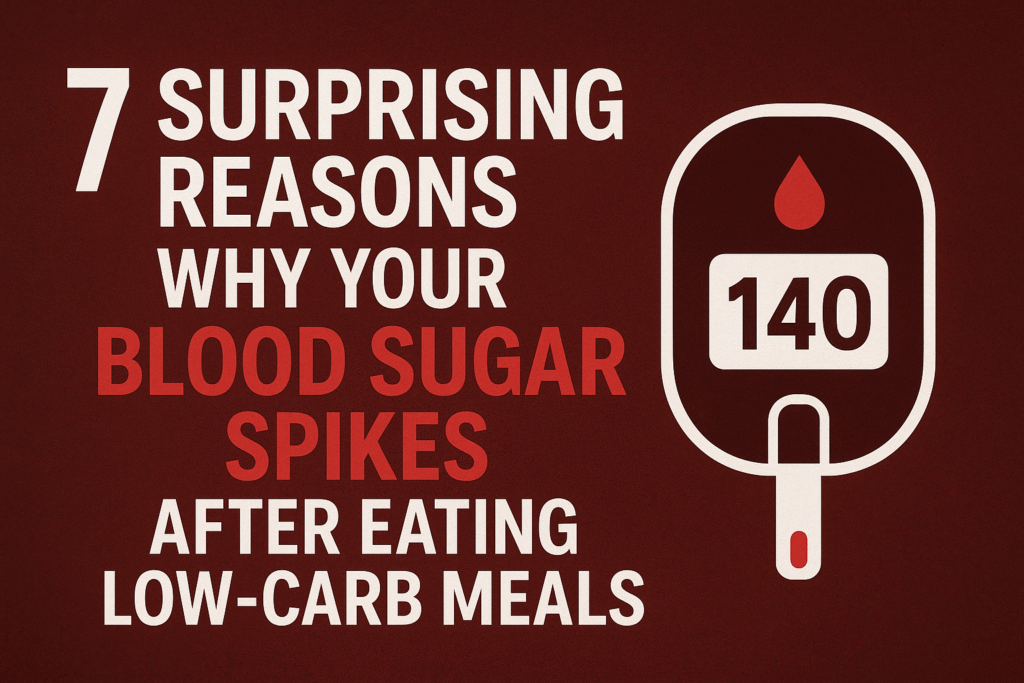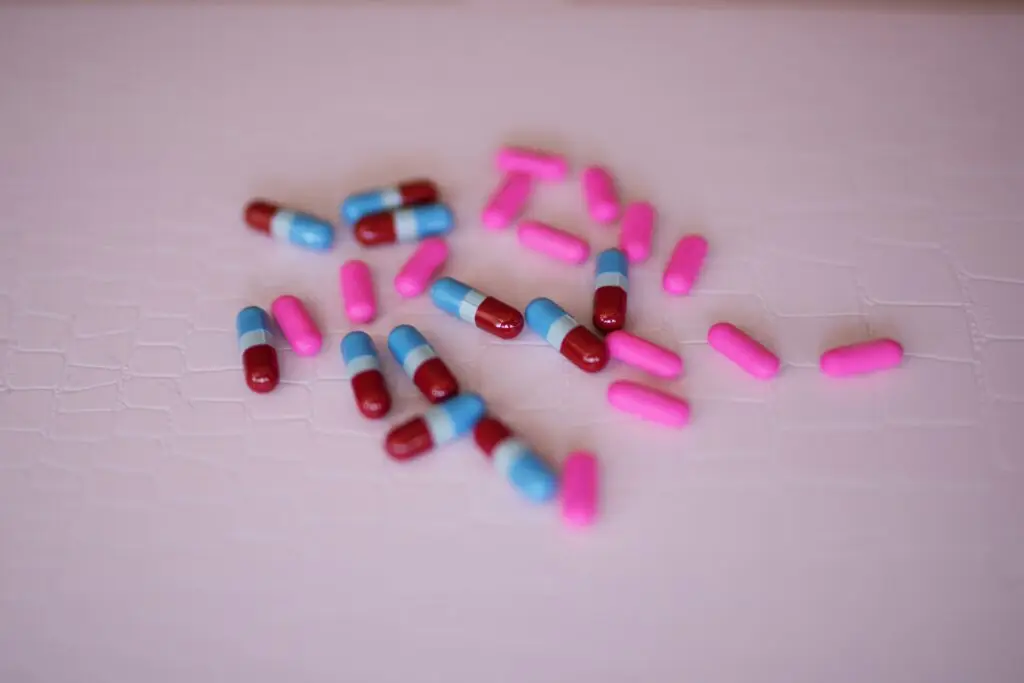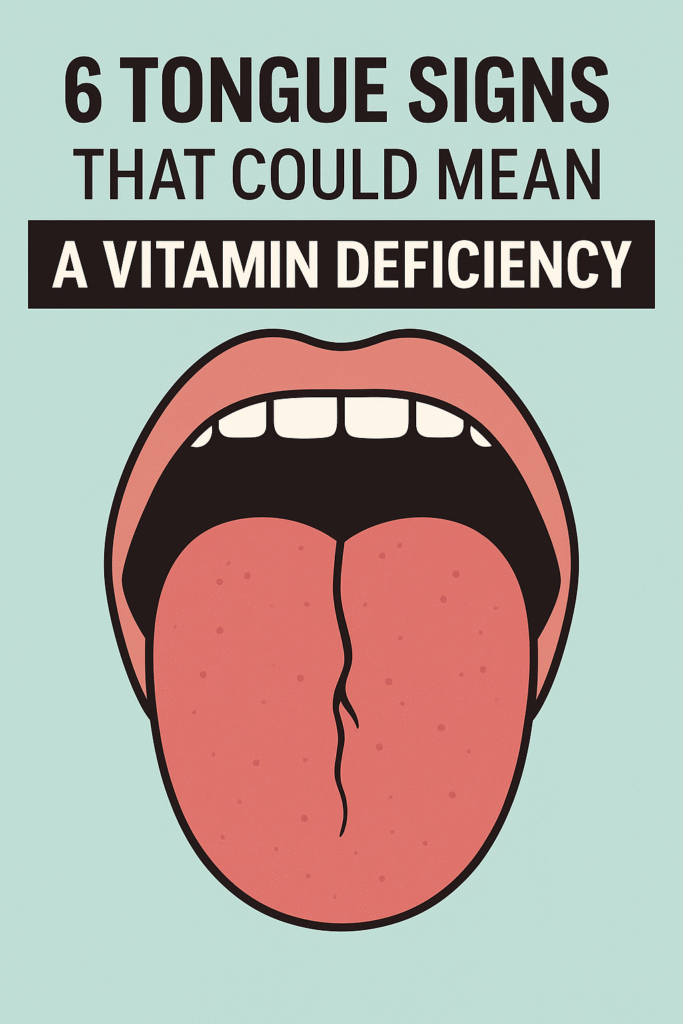
⚠️ Affiliate Disclaimer: This post may contain affiliate links, which means I may earn a small commission — at no extra cost to you — if you make a purchase through one of these links. I only recommend products or services I genuinely trust and believe can provide value. Thank you for supporting My Medical Muse!
7 Surprising Reasons Why Your Blood Sugar Spikes After Eating Low-Carb Meals
Low-carb diets are famous for their ability to keep blood sugar levels stable. So it can be confusing even alarming when your glucose monitor suddenly shows a spike after a meal that barely contained 20 grams of carbs.
If you’ve ever caught yourself thinking, “Wait… I barely ate any carbs, why is my blood sugar high?”, you’re not alone. Many people on low-carb, keto, or diabetic-friendly diets experience the same puzzling reaction.
The truth is, blood sugar regulation is more complex than just carb counting. Your body’s internal systems hormones, stress responses, metabolism, and even your liver can all play a role in post-meal glucose spikes.
Let’s break down the real science behind why this happens and what you can do to fix it.
1. You’re Experiencing the “Dawn Effect” or Morning Insulin Resistance
If your low-carb breakfast seems to send your blood sugar soaring, the problem might not be your meal, it could be your hormones. When you wake up, your body naturally releases a surge of hormones such as cortisol, adrenaline, and glucagon. These “wake-up” hormones prepare your body for the day by stimulating your liver to release stored glucose (glycogen) into your bloodstream. This process ensures your brain and muscles have enough energy to start the morning.
This early morning rise in glucose is called the dawn phenomenon or morning insulin resistance and it’s completely normal. However, in some people (especially those who are insulin resistant or have prediabetes), this effect is more pronounced, causing a noticeable post-breakfast spike even without carbs.
You might eat something perfectly healthy like eggs, spinach, and avocado and still see your blood sugar jump from 90 mg/dL to 130 mg/dL.
That rise isn’t from your food, it’s your liver releasing extra glucose in response to morning hormones.
Your insulin sensitivity is typically lowest in the morning, meaning your body requires more insulin to manage even small amounts of glucose. So that low-carb breakfast gets caught in a hormonal wave that temporarily spikes your readings.
What to Do
Here are small adjustments that can dramatically reduce morning glucose spikes:
- Delay breakfast, wait 60-90 minutes after waking before eating. This gives your cortisol and glucose levels time to settle naturally.
- Hydrate first, start your day with a large glass of water (or water with electrolytes) before coffee or food. Hydration helps your kidneys process excess glucose more efficiently.
- Move lightly, take a 10-15 minute walk after eating or do gentle stretches. Muscles use glucose as fuel, helping clear it from your bloodstream faster.
- Mind your caffeine, drinking coffee immediately upon waking especially black coffee can raise cortisol and further elevate glucose. Wait 30-45 minutes before your first cup.
That early spike after a low-carb breakfast doesn’t mean you did anything wrong, it’s your body’s natural rhythm. With a few timing tweaks, you can flatten that curve easily.
2. Fat and Protein Can Still Raise Blood Sugar Indirectly
Many people assume that only carbohydrates raise blood sugar. But that’s not entirely true. Both protein and fat can influence glucose levels, just more subtly and over a longer time frame.
When you eat a low-carb, high-protein meal, like a steak and eggs breakfast or chicken salad with olive oil, your body can convert some of that protein into glucose through a process called gluconeogenesis.
The Science:
Gluconeogenesis literally means making new glucose.
It’s a metabolic process that occurs in the liver (and to a smaller extent in the kidneys), allowing your body to maintain normal blood sugar levels when dietary carbs are scarce.
This process is essential for survival, it prevents your blood sugar from dropping too low during fasting or very low-carb diets. However, in people who are insulin resistant, have metabolic inflexibility, or are under stress, gluconeogenesis can become overactive, leading to unexpected glucose rises even in the absence of carbs.
What to Do:
You don’t need to fear protein, but you should balance it.
- Keep protein moderate: Aim for 0.8-1.2 grams per pound of lean body mass (not total weight). Too much protein can trigger glucose formation.
- Add fiber and vegetables: Non-starchy veggies (broccoli, spinach, kale) provide fiber that slows digestion and absorption, helping control post-meal glucose.
- Include healthy fats: Fats like avocado, olive oil, nuts, or fatty fish slow gastric emptying, reducing the rate at which amino acids are converted into glucose.
- Time your meals: Large, high-protein meals late at night can cause overnight glucose elevations, try keeping them earlier in the day.
Even low-carb meals can trigger glucose rises if protein intake is high. Balancing macronutrients and adding fiber can keep those numbers steady.
3. Stress and Cortisol Spikes
Even if your meal is perfectly low in carbs, your stress levels can cause your blood sugar to behave as if you just ate dessert.
When you’re stressed, whether it’s due to lack of sleep, work pressure or emotional strain, your body releases stress hormones like cortisol and adrenaline. These hormones tell your liver to release stored glucose into your bloodstream so you have quick energy for “fight or flight.”
This mechanism is ancient and protective but in modern life, where stress often means back-to-back meetings, financial worries or too little rest, that glucose release becomes chronic, leading to frequent spikes even when your diet is perfect.
Chronic stress doesn’t just cause temporary spikes, it can also worsen insulin resistance over time. When cortisol stays elevated, cells stop responding efficiently to insulin, forcing your pancreas to produce more of it. That means even small amounts of glucose linger in the bloodstream longer.
What to Do:
The goal isn’t to eliminate stress (impossible), but to train your body to handle it better:
- Practice deep breathing before meals. Try a simple rhythm: inhale for 4 seconds, exhale for 6 seconds, repeat for 2 minutes before eating. This activates your parasympathetic (“rest and digest”) system.
- Prioritize quality sleep: Poor sleep raises cortisol and glucose the next day. Aim for 7-8 hours consistently.
- Move your body: A 10-minute post-meal walk helps your muscles soak up glucose and lowers cortisol at the same time.
- Moderate caffeine intake: Too much caffeine on an empty stomach spikes cortisol. If you’re sensitive, switch to green tea or have coffee after a meal.
- Try relaxation techniques: Meditation, journaling, yoga, or even light stretching can regulate your body’s stress response.
Stress can raise blood sugar just as effectively as carbohydrates. Managing cortisol through sleep, movement, and mindful eating can make as much difference as any dietary tweak.
4. You Have Hidden Insulin Resistance
If your fasting blood sugar or A1C is creeping up despite sticking faithfully to your low-carb diet, insulin resistance may be silently at play.
Insulin resistance means your body’s cells, particularly in the muscles, liver, and fat tissue, don’t respond efficiently to insulin. Normally, insulin acts like a “key” unlocking cells so glucose can enter and be used for energy, but when the “locks” become rusty or unresponsive, glucose lingers in the bloodstream longer, resulting in higher post-meal spikes even from small amounts of food.
Key Signs of Hidden Insulin Resistance
You might be insulin resistant even if your fasting blood sugar looks fine. Watch for these subtle clues:
- Normal fasting sugar, but elevated readings after meals (postprandial spikes above 140 mg/dL).
- Energy crashes or brain fog even after eating low-carb foods.
- Difficulty losing weight, particularly around the midsection, despite a disciplined diet and exercise routine.
- High triglycerides or low HDL on blood tests, both metabolic warning signs.
Insulin resistance develops gradually from multiple factors:
- Chronic stress and elevated cortisol, which keep blood sugar high.
- Poor sleep, reducing insulin sensitivity by up to 25% after just one bad night.
- Micronutrient deficiencies, especially magnesium, chromium, zinc, and omega-3 fatty acids, which are essential for insulin signaling.
- High intake of saturated fats (especially without balancing omega-3s or fiber).
- Sedentary lifestyle, which reduces glucose uptake by muscles.
Even if your carb intake is minimal, these factors can make your body less responsive to insulin, causing sugar to remain elevated longer than expected.
What to Do:
- Add resistance training or HIIT 3-4 times weekly. Muscles act as glucose sinks and dramatically improve insulin sensitivity.
- Support micronutrients: Ensure you’re getting enough magnesium, omega-3s, and zinc through diet or supplementation.
- Cycle your carbs occasionally: Incorporating moderate-carb days (e.g., 80-100g from vegetables or sweet potatoes once or twice weekly) can reset metabolism and improve insulin response.
- Prioritize sleep and recovery: Your cells restore insulin sensitivity during deep sleep, skimping on rest stalls your progress.
Low-carb diets help, but they can’t outpace hidden insulin resistance. Combining nutrient balance, movement, and recovery is the true fix.
5. You’re Eating Too Quickly or in the Wrong Order
Believe it or not, how you eat can matter as much as what you eat. If you eat too quickly, or if you eat your carbs before protein and vegetables, your body can overreact by releasing insulin too fast. This can cause a rapid rise and fall in glucose levels, leaving you tired, foggy, or even hungrier shortly after eating.
Why Meal Order Matters:
Studies show that eating fiber and protein before carbs can reduce post-meal glucose spikes by up to 70%.
Here’s why:
- Fiber slows down the digestion of carbohydrates.
- Protein and fats delay gastric emptying (how quickly food leaves the stomach).
- Carbs last means glucose enters the bloodstream more gradually, allowing insulin to respond at a controlled pace.
The Best Order for Stable Glucose:
- Veggies first: fiber slows sugar absorption.
- Protein and fats next: Delay digestion and reduce the glucose rush.
- Carbs last (if any): Smallest glucose peak, longest-lasting energy.
What to Do:
- Eat mindfully: Slow down, aim for 20 minutes per meal and chew thoroughly. Distractions like phones or TV make overeating and quick bites more likely.
- Sequence your meals: Even if you’re having something small, like a wrap or omelet, eat the fiber-rich veggies first.
- Try apple cider vinegar: Take 1 tablespoon in a glass of water about 10-15 minutes before eating. It improves insulin sensitivity and slows glucose absorption.
- Walk after eating: Pair meal sequencing with gentle movement for maximum benefit.
Glucose control isn’t just about what’s on your plate, it’s about how and when you eat it. Meal order and pace can make or break your blood sugar curve.
6. Your Liver Is Dumping Glucose (Glycogen Rebound)
Your liver is a glucose storage powerhouse. It keeps a reserve of glycogen, a stored form of glucose that it releases as needed to maintain energy between meals or during fasting.
When you cut carbs drastically or fast for long hours, your liver may “panic” and overcompensate by dumping glucose into the bloodstream. This glycogen rebound is your body’s way of ensuring you don’t run out of fuel, but it can cause an unexpected spike, especially after a high-protein or high-fat meal.
Why It Happens:
- Your liver senses “low fuel” and releases glucose preemptively.
- You’ve recently transitioned into low-carb eating or just ended a fast.
- You’re under stress, which signals your liver to release sugar for emergency energy.
The liver doesn’t differentiate between “I’m hungry” and “I’m in danger”. In both cases, it sends glucose into your bloodstream.
What to Do:
- Stay consistent, Avoid swinging between zero-carb and moderate-carb days. Your liver adapts better when intake is predictable.
- Pair protein with fiber: Adding vegetables or healthy fats to protein-rich meals helps buffer this effect.
- Avoid long fasting windows: If your goal is glucose stability. Extended fasts (18-24 hours) can make rebounds more frequent.
- Track your data: Use a CGM or glucometer to spot patterns, when spikes occur, what you ate before, and how long they last. This helps distinguish normal physiology from potential insulin resistance.
Sometimes, glucose spikes on low-carb aren’t diet failuresthey’re liver reflexes. Consistent intake and gentle activity can retrain your metabolism to stabilize naturally.
7. Hidden Carbs, Additives or Artificial Sweeteners
Not all “low-carb” foods are truly low-carb. Many contain hidden sugars, sugar alcohols, or insulin-spiking additives that sneak past nutrition labels.
For example, “keto” bars, sauces, or protein shakes might use maltitol, sucralose, or maltodextrin sweeteners that still raise blood sugar and insulin in some people. Even small amounts can trigger noticeable glucose responses in sensitive individuals.
Common Hidden Culprits
- Sugar-free or no added sugar chocolate
- Low-carb tortillas or baked goods with modified starches
- Protein powders that use maltodextrin as a filler
- Flavored coffee creamers and zero sugar syrups
- Certain sugar alcohols (maltitol, sorbitol, isomalt)
Many of these sweeteners cause individual glucose variability. One person may tolerate erythritol or stevia fine, while another spikes from the same product.
What to Do:
- Read labels carefully: Don’t trust marketing buzzwords like “keto-friendly” or “diabetic-safe.”
- Choose natural sweeteners: Use monk fruit, stevia, or erythritol, which have minimal glucose impact.
- Stick to whole foods: Whole, unprocessed meals keep your blood sugar predictable.
- Test your response: If you use a CGM, try testing one new packaged product at a time and see how your glucose reacts over 2-3 hours.
Even on a low-carb diet, processed “keto” foods can betray you. The fewer ingredients, the more reliable your blood sugar control.
Post-Meal Spikes Aren’t Always Bad
Here’s an important reminder: not all blood sugar spikes are harmful.
A small, temporary rise (up to 140 mg/dL) after eating is completely normal, your body needs glucose for energy.
What matters more is how high and how long your blood sugar stays elevated:
- Frequent or large spikes above 160 mg/dL can indicate metabolic stress.
- Levels that take more than 2-3 hours to return to baseline suggest reduced insulin efficiency.
Using a Continuous Glucose Monitor (CGM) like the Freestyle Libre or Dexcom G7 can help you understand your personal glucose patterns. Two people can eat the same low-carb meal and experience totally different spikes due to genetics, stress, sleep, or gut microbiome differences.
When to Worry:
If your post-meal numbers are consistently high despite low-carb eating, talk to your healthcare provider. It may be time to evaluate:
- Insulin resistance or prediabetes
- Adrenal or thyroid imbalances
- Liver function issues
The Positive Spin:
Occasional glucose bumps after low-carb meals can be a sign of flexibility, meaning your body is capable of generating and using glucose when needed. The goal isn’t a perfectly flat glucose line, it’s a stable, responsive one.
Putting It All Together: How to Fix Low-Carb Glucose Spikes
Here’s a step-by-step framework to stabilize blood sugar, even on a low-carb diet:
1. Track Before You Guess
Use a glucometer or CGM for 2 weeks. Note:
- When spikes happen
- What foods or stressors preceded them
2. Prioritize Meal Timing
Your insulin sensitivity fluctuates through the day.
You’re typically more insulin-sensitive midday than early morning or late night.
Try moving your main meal to lunchtime or early evening.
3. Add Movement After Meals
A simple 10-15 minute walk or light stretch after eating reduces glucose spikes by 20-30%.
Muscles act like glucose sponge, they pull sugar out of the blood without needing insulin.
4. Balance Macronutrients
For every meal, aim for:
- 50% non-starchy vegetables
- 25% quality protein
- 25% healthy fats
Even low-carb diets benefit from balance, too much of one macronutrient (especially protein) can cause rebounds.
5. Support Gut and Liver Health
Impaired gut microbiome or sluggish liver function can worsen post-meal spikes.
Support them with:
- Probiotics & fermented foods (yogurt, sauerkraut)
- Hydration & fiber (helps excrete excess glucose)
- Sleep & stress regulation (your liver resets during deep sleep)
When to Talk to Your Doctor
If your blood sugar remains high after every low-carb meal, especially above 180 mg/dL, it’s important to check for underlying conditions like:
- Insulin resistance or prediabetes
- Adrenal fatigue or chronic stress
- Liver or thyroid dysfunction
A doctor can order:
- Fasting insulin & glucose
- HbA1c (3-month average)
- Cortisol or thyroid panels
You may not need medications, but data helps personalize your nutrition plan.
The Takeaway
Seeing your blood sugar spike after eating low-carb doesn’t mean your diet “failed.”
It’s your body sending a message: “Something else is influencing glucose regulation.”
Most of the time, the culprit isn’t carbs, it’s:
- Hormonal timing (cortisol, dawn effect)
- Protein/fat conversion (gluconeogenesis)
- Stress, sleep, or eating patterns
When you understand these root causes and make small adjustments like walking after meals, eating slowly, or balancing macros, you’ll see steadier glucose curves, more energy, and better long-term metabolic health.
👩⚕️ Need Personalized Health Advice?
Get expert guidance tailored to your unique health concerns through MuseCare Consult. Our licensed doctors are here to help you understand your symptoms, medications, and lab results—confidentially and affordably.
👉 Book a MuseCare Consult NowRelated Blog Post You Might Like:
- Can Dehydration Raise Your Blood Pressure? 10 Powerful Reasons Why
- 10 Proven Benefits of Nutritional Counseling for Diabetes Management
- Can Intermittent Fasting Help Type 2 Diabetes? 9 Powerful Facts
- 10 Sneaky Symptoms of Prediabetes in Women Over 40 You Can’t Ignore
- 10 Proven Tips on How to Interpret Hemoglobin A1c Levels Accurately
- Sweet Taste in Mouth: Shocking Signs It’s a Vitamin Deficiency
- 7 Proven Ways to Prevent Pressure Ulcers in Wheelchair-Bound Patients


